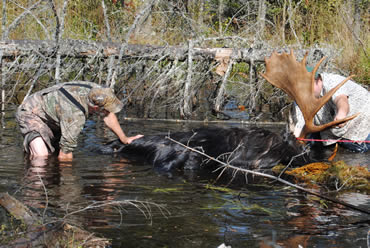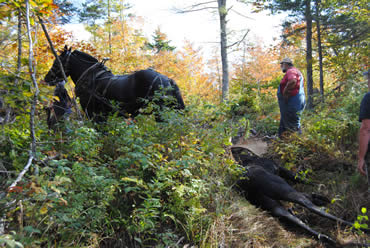Vermont’s finest bull by bow no longer lives there.
Hungry for a new challenge, Brad Thornsberry and his wife Martina decided in 2012 to look beyond their beloved Kentucky.
Spurred by descriptions of New England’s beauty and plentiful game, husband and wife (operators of Beaver Creek Outfitters in Knott County) applied for moose tags in Vermont and Maine. But their names were not drawn.
Aware they might never acquire the coveted tags, husband and wife nevertheless applied again in June 2013. They figured the best bet might be archery tags in Vermont, since such licenses were still fairly new there. But either bow or gun would do.
“The moose hunt draw in Vermont is a really big thing,” Tina said. “The event is covered live by local TV, and the Governor does the actual drawing. Gun hunting has been a long tradition, but (2012) was only the third time the state had issued archery tags for moose.
“There would be 50 tags drawn for bowhunting, and 10 percent of those would go to nonresidents. Brad put in for a tag to bowhunt, and I put in for gun,” she continued. “On the day of the draw, I was having a yard sale, and we didn’t get to look at the results online until about an hour after the lottery was finished.
“We could hardly believe our eyes,” Tina said. “Brad had drawn one of the five nonresident moose tags to be issued to bowhunters.”
The seven-day, 2013 archery season began Oct. 1. To clear their slate, Brad and Tina accepted a booking from only one elk hunter and set about looking for their own guide in Vermont.
“One of our past elk hunting clients from New York had hunted moose with a guide named Cory Curtis. We had already connected with Cory on Facebook,” he continued. “He’s just sort of a local boy bouncing around up there trying to get by.
“I called him 20 minutes after we found out I had been drawn, and I had my guide,” Brad added.
Vermont is one of several states that allow an archery hunter to designate a sub-permit holder who can also go along and hunt.
“The two hunters are only allowed one moose between them, and they must hunt together,” Tina said. “But the sub-permit holder may also shoot at the moose. Sort of a backup shooter.
“I really wanted to go along with Brad as the sub-permit holder, but after trying for some time, we decided I couldn’t shoot a bow with enough poundage to kill a moose, so we abandoned that idea.”
When that was decided, Brad turned to David Blankenship of West Virginia.
“We had guided David on a successful elk hunt. I knew he was a bowhunter, and I could count on him,” Brad said. “He knows what he’s doing. I called David, and we talked. Pretty soon, I had my sub-permit holder.”
 If you can beat the drawing odds, the cost of a Vermont moose hunt is relatively modest compared to a lot of other big game species or even compared to moose hunts in other states or Canadian provinces. The cost to put in for the draw is $25 for a nonresident.
If you can beat the drawing odds, the cost of a Vermont moose hunt is relatively modest compared to a lot of other big game species or even compared to moose hunts in other states or Canadian provinces. The cost to put in for the draw is $25 for a nonresident.
After being drawn, the hunter is required to purchase a nonresident moose tag for $350. Hunter and sub-permit holder are each required to have a moose tag.
Another expense that is almost mandatory is a “horse puller” to get your moose out of the woods. Rental horses are easy to find in all areas of the state open to moose hunting. The cost averages around $150, depending on how long it takes to get it done.
Finally, you can expect to pay somewhere between $1,000 and $3,000 for a guide, depending on the amount of services included.
Finding a place to hunt is no problem. Timber companies have vast holdings in Vermont that are prime moose habitat.
Moose love to eat the bark from small saplings replanted by the timber companies, so the animals aren’t exactly loved by the companies, which are more than happy to allow hunting. In fact, some businesses even reimburse successful hunters for their horse rental fee.
With archery season set to open on Tuesday, Oct. 1, Brad and Tina made plans to pick up David in West Virginia and drive to Vermont.
“There’s no way I was going to stay home, since it’s my favorite thing to do, even if I wasn’t going to be hunting,” Tina said. “We left Saturday afternoon and drove the four hours to David’s in West Virginia. The next morning, we got up and drove the remaining seven hours to Vermont.
“We had rented a river house, and the countryside was beautiful. The waterway in front of the house was part of the National Canoe Trail, and we had the use of a canoe,” she continued.
“The guys used Monday just to get over the trip and sight-in their bows, and we enjoyed playing around with the canoe and checking out the area,” she said.
On Tuesday morning, after meeting with Cory, the party drove out before daylight to hunt moose. The first stop was for a cup of hot chocolate.
“Cory said that was his good luck ritual,” Brad said.
“We drove on out a logging road and parked at a landing where the company had been logging. The amount of open land up there is just enormous,” he continued.
“We got out in the crisp air and started walking up a logging road as it was getting daylight. The sweet smell of big woods was all around us.
 “Cory started to call. He was just using his mouth with no kind of call, but it sounded good. I think you probably need a Vermont accent to call moose,” he said.
“Cory started to call. He was just using his mouth with no kind of call, but it sounded good. I think you probably need a Vermont accent to call moose,” he said.
“Almost immediately, we saw a large four-legged animal moving back in the overgrown briars. The animal was about 100 yards distant, but it was still too dark to make out for sure what it was. It moved off, and we tried to follow, but the stuff we were in was really thick.
“We moved off to the side a little bit, and Cory called again. The next thing we knew, the animal was behind us, and you could hear him walking and could hear low under-the-breath grunts.
“Suddenly, the moose got downwind, and we could hear him take off like a horse. Cory said he didn’t chase after spooked bulls, so we headed back to the truck. Less than 15 minutes of hunting, and we’d already had a close encounter with a bull!
“We got in the truck and drove about a mile down the road. By that time, it was daylight. The next time we stopped, we got out and walked a ways and then set up on an old skidder road before Cory started calling.
“On the walk in, we saw fresh tracks as big as plates on the old road. We were already fired up from the first encounter, and the tracks only made us more so. David and I set up on each side of the road, and Cory got behind us and started calling.
“In just a matter of minutes, David made eye contact with a big bull. I couldn’t see him. David was pointing where it was, as the agreement was that I was going to shoot first since it was my tag.
“The bull started raking a tree. All of a sudden, it got even more interesting. A small bull started coming to the call, too, and the big one stopped whipping up on the tree and moved to head it off. At about 75 yards, it turned and came strutting and grunting right down the road.
“The big bull was at 20 yards and about to hit David’s scent cone when I put an arrow in its chest. My first shot buried up in there, but didn’t do the job. As the moose wheeled to run, it dipped down, and David’s arrow just cut hair on his back.
“David managed to get another arrow out and hit the bull before it disappeared into a thicket.
“We gave the bull an hour, sitting around and high-fiving and trying to get settled. An hour on the dot after we shot the bull, I made Cory leave. There was a good trail. I just knew we would find it dead.
“It looked like there was blood 10 feet up on trees in places. It was that way, off and on, for half a mile, and then it dwindled away to almost nothing.
“About that time, we caught up to the animal. We couldn’t see it, but heard it take off and started following the sound. The stuff the moose was moving through was unbelievably thick.
“I tried one shot, but the arrow hit brush. We came out into a clearing, and the bull was knee-deep in a beaver pond, waving its antlers almost like it wanted to charge, but David launched the coup de grâce, and the bull collapsed in the water. Cory came up, took one look at the giant rack, and said, ‘Oui, that’s a trophy there!’”
After the 60-day drying period, the giant grossed 184 4/8 and netted 174 4/8 Pope and Young — a new state record by the size of the rack (some people use weight as the measure of trophy status up there). The previous record netted 163 5/8.
This article was published in the April 2016 edition of Rack Magazine. Subscribe today to have Rack Magazine delivered to your home.
Read Recent RACK Articles: • Green, Green Grass of Away: Cincinnati hunter discovers I-275 is the road to Heaven.
• Getting a Goodun: Georgia hunter values marksmanship and old-fashioned luck over all things fancy.
• Beaten by the Path: Eighteen-pointer’s fatal mistake was taking the same trail twice, just a few hours apart.